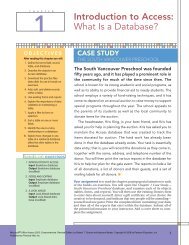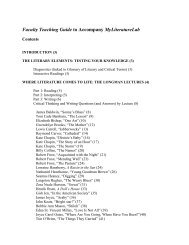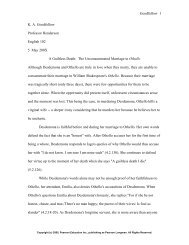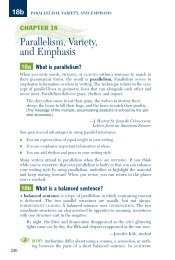chapter 3 - Pearson Learning Solutions
chapter 3 - Pearson Learning Solutions
chapter 3 - Pearson Learning Solutions
Create successful ePaper yourself
Turn your PDF publications into a flip-book with our unique Google optimized e-Paper software.
2009934667<br />
Chapter 3 Nonverbal Communication 75<br />
Culture and Space When people from different cultural backgrounds come<br />
into contact, they may assume they have the same concept of space. This, of course,<br />
is not true. In fact, “cultures can be distinguished by the distances at which members<br />
interact and how frequently members touch.” 81 It has been proposed that<br />
there are contact cultures—those characterized by tactile modes of communication<br />
(e.g., Latin Americans, Mediterraneans, French, Arabs)—and noncontact<br />
cultures (Germans, Japanese, English, North Americans). 82 Although heterosexual<br />
men in the United States and England rarely touch other men, except in times of<br />
great emotion (such as athletic game victories) or for shaking hands when welcoming<br />
or meeting someone, arm linking between two men is common in Turkey,<br />
Morocco, and many Latin American countries. 83<br />
Even within our own culture, the space bubble varies according to our emotional<br />
state and the activity. Although European Americans usually keep well<br />
beyond the three-foot personal circle of space, this can change very quickly. If you<br />
are on a crowded bus and someone presses against you, you may tolerate it. If,<br />
however, you are standing at a bus stop and someone presses against you, you will<br />
probably object. This situation brings into play your idea of public distance.<br />
Your emotional state also can change your idea of space. For instance, when<br />
some people are angry, they may grab someone by the front of the shirt, step in<br />
close, get “nose to nose,” and shout.<br />
Space Distances An examination of space distances allows for an understanding<br />
of space as it relates to culture. Everyone has spatial needs. Studies of the space<br />
We can often get clues<br />
about a relationship by<br />
noticing whether the person<br />
allows us to use his or<br />
her intimate space.<br />
Communicating: A Social and Career Focus, Tenth Edition, by Roy M. Berko, Andrew D. Wolvin, and Darlyn R. Wolvin. Published by Allyn & Bacon.<br />
Copyright © 2007 by <strong>Pearson</strong> Education, Inc.
















